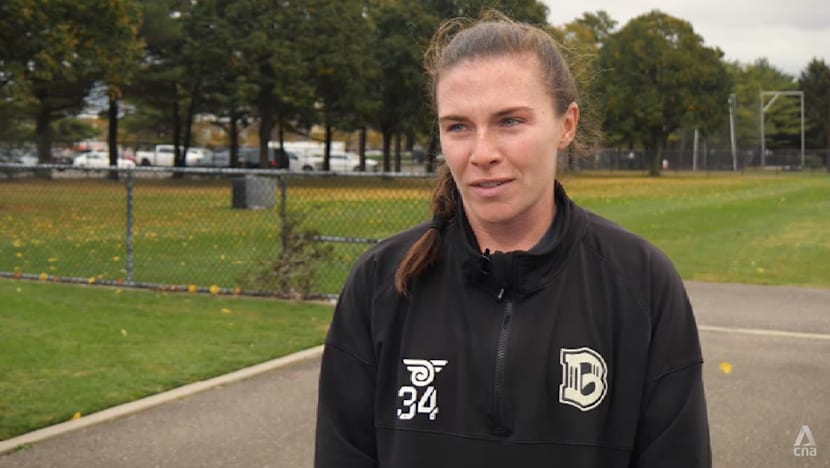Women's sports gaining momentum in US, but long road to equality remains
Analysts say the women’s sports sector in America could be worth billions of dollars by 2030, but deep-rooted inequalities continue to hold it back.

At New York's Brooklyn FC, players say that brands are showing greater interest in partnering with them.

This audio is generated by an AI tool.
NEW YORK: Women’s sports in the United States are enjoying unprecedented momentum, driven by rising viewership and commercial interest.
However, experts caution that gender parity in visibility, sponsorship and prize money remains a distant goal.
While forecasts suggest the US women’s sports market could be worth billions of dollars by the end of the decade, analysts say sustainable growth will depend on building deeper and more consistent fan engagement.
Much of the current boom has been fuelled by athletes who dominated global events and have become household names.
At the 2024 Paris Olympics, for example, around 30 million Americans tuned in daily to watch stars such as gymnast Simone Biles, basketball player Diana Taurasi and footballer Sophia Wilson.
TV ratings for women’s sports have also grown significantly.
In 2024, more Americans watched the final of the women's college basketball national championship than the men’s, a success which could boost commercial opportunities for the sector.
RIDING NATIONWIDE TAILWINDS
At New York's Brooklyn FC – which was founded two years ago and plays in the newly launched USL Super League, a Division One women’s professional competition – players say that brands are showing greater interest in partnering with them.
“There's so much more opportunity,” said defender Kelsey Hill.
“I think the fans and getting all the noise around it and everything on social media, having the TV deals - there's so much more.”
“The time for women’s sports has arrived, and I think the time for it to go exponentially larger is here,” said Tom Lyons, the club’s chief marketing officer.
He added that he feels the excitement among sports fans, crediting the surge in interest to the strong “tailwinds” created by women’s basketball and the US women’s national soccer team.
The Women’s National Basketball Association (WNBA) enjoyed a historic 2024 season – driven by standout rookie players such as Caitlin Clark and Angel Reese – and the momentum has carried into 2025.
This surge has helped push women’s competitions further into mainstream sports culture.
In football, the US women’s national soccer team, which successfully lobbied for equal pay with the men’s team, continues to wield cultural and commercial clout. It remains the most successful team in international women’s soccer.

STARK REALITY FOR WOMEN
Despite that growth, players and experts warn that equality with men’s sports is still a long way off.
Hill said pursuing a sports career comes with sacrifices. Female athletes still face significant pay disparities with men, and in many cases, their contracts pale in comparison to those offered to men.
Many are unable to earn a sustainable income through their sport alone, she added.
“If we graduate and pursue a job or work or anything with our degree, we would be making a lot more money than we do playing soccer,” she said.
“A lot of my teammates are working second jobs or trying to have an additional income because it's not really enough to support us fully.”
However, she added that when it comes to resources, some situations are better in the US than in her experience playing overseas, where her club’s men’s team was given access to a training facility her team could not use, and the men were provided cars while the women rode bikes to practice.
Lyons noted there is often an assumption that women’s football is thriving commercially simply because other women’s sports are. Basketball, he said, is about 15 years ahead of football in its commercial success.
New York University academic director Gina Antoniello, who has worked with some of America’s top sporting organisations, said the headline numbers – from rising viewership to improved sponsorship interest – still represent only a fraction of the overall sports economy.
She described the sector’s growth as “not a moment, but a movement”, the result of years of important activism. But there is still a long way to go, she added.
“With sponsorship revenue up, that's great, but it's still at 8 per cent of entire sponsorship budgets,” she said.
“With women's sport coverage, it's up … with great broadcast deals at primetime spots. The broadcast revenue is being priced a lot lower.”
Antoniello added that change is also needed within sporting institutions themselves.
She noted that she was one of the first women to oversee a communications department for an American professional football team as recently as 2019.
“Why is that in 2019? I don't like to … think I'm that old for that to happen? So what we're seeing is exclusionary power.”
MORE AVID FANS NEEDED
In a recent report, consulting firm McKinsey said women’s sports could generate at least US$2.5 billion in value for rights holders by 2030.
It also found that between 2022 and 2024, revenue from women’s sports grew 4.5 times faster than that of men’s.
But several obstacles remain, such as less favourable broadcast slots for women’s sports, the report noted.
Another is what McKinsey partner Ben Vonwiller described as fragmented fan attention, where women’s teams are fighting for attention in a crowded market.
“There are many more sports properties available for a fan to consume. And what we are seeing with women's sports fans is that when they pick up women's sports, they're not dropping another sport,” Vonwiller said.
“They're simply adding it rather than substituting. And that means there's much more competition for their attention.”
But the biggest challenge is turning casual fans into highly engaged avid ones who tend to generate much more revenue, he added.
McKinsey’s report found that 39 per cent of women’s sports fans consider themselves avid, compared with 69 per cent of men’s sports fans.
“They need to create more avid fans to look more like men's sports, where the spend is highest, and they need their casual fans to become less casual. That means watching more games and attending more games,” Vonwiller added.
“That will be a meaningful driver to closing the revenue gap.”

While challenges remain, Brooklyn FC forward Catherine Zimmerman, who is nearing retirement, said she has witnessed significant progress throughout her career.
“It's just created so many opportunities for us to be employed playing soccer. I'm definitely fortunate. I'm nearing the end of my career, so I feel like I'm getting the tail end of that opportunity.”
Lyons shares that optimism. The club has partnered with several local sponsors to grow its brand among the 2.6 million people who live in Brooklyn, with initiatives such as themed match nights, including one where fans can bring their pets.
Matches are also being televised, allowing new audiences to engage with what Lyons called an “incredibly good product”.


















